MEET GRANDMA LORINE
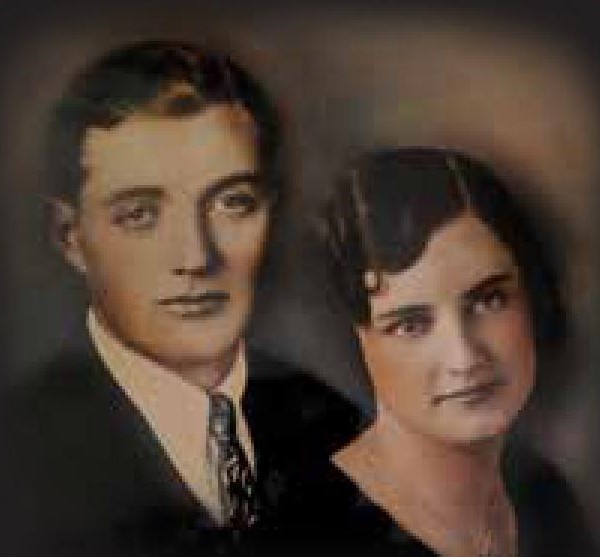
1911
A Legend is Born
Lorine Sextro was born in Halbur, Iowa November 22, 1911. She married Frank Sextro in 1932. They made their home on Frank’s family farm between Templeton and Manning in Carroll County.
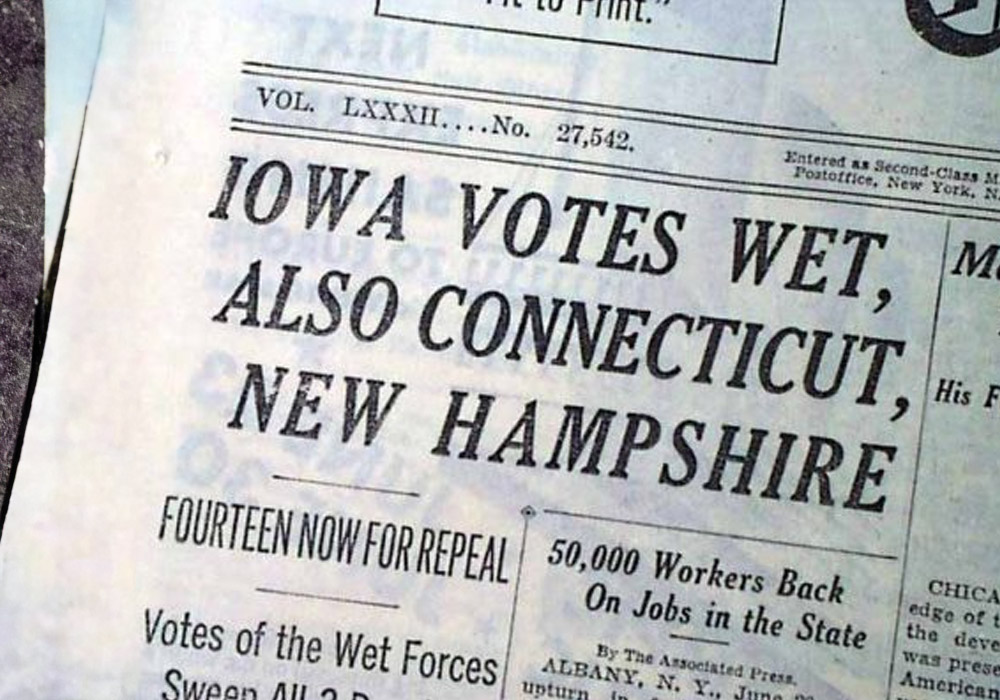
1917
Iowa Votes on Prohibition
With pressure to criminalize the sale and consumption of alcohol rising, Iowa voters reject a state Prohibition referendum on October 15, 1917, by 50.1% to 49.9% allowing alcohol sales to continue.
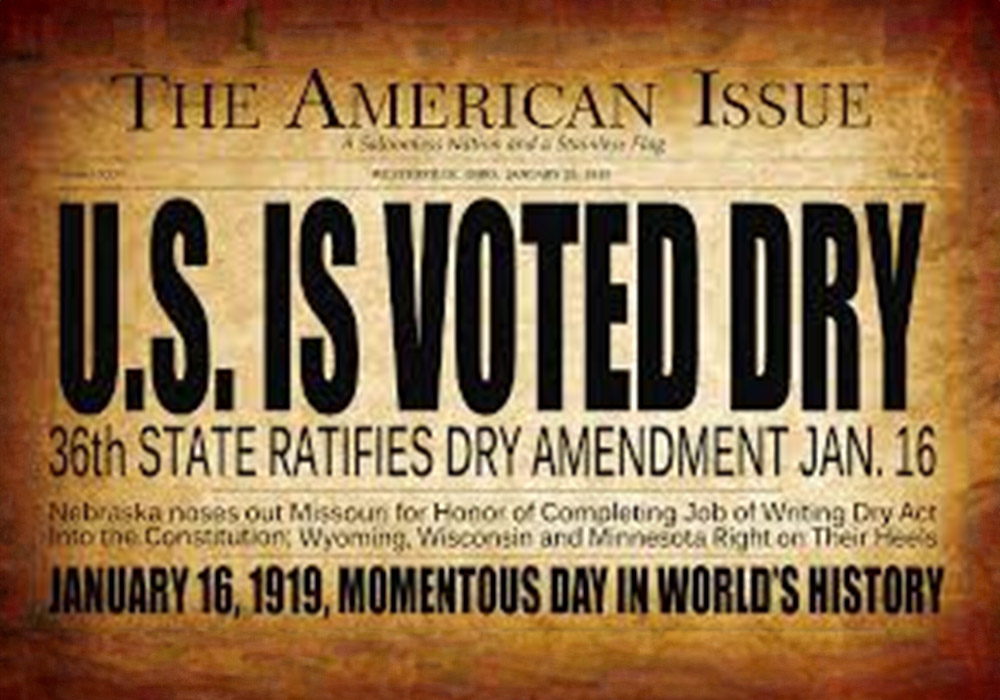
1919
18th Amendment Passes
The Federal government passes the 18th Amendment on October 28, 1919, banning all alcohol production and sales in the United States.
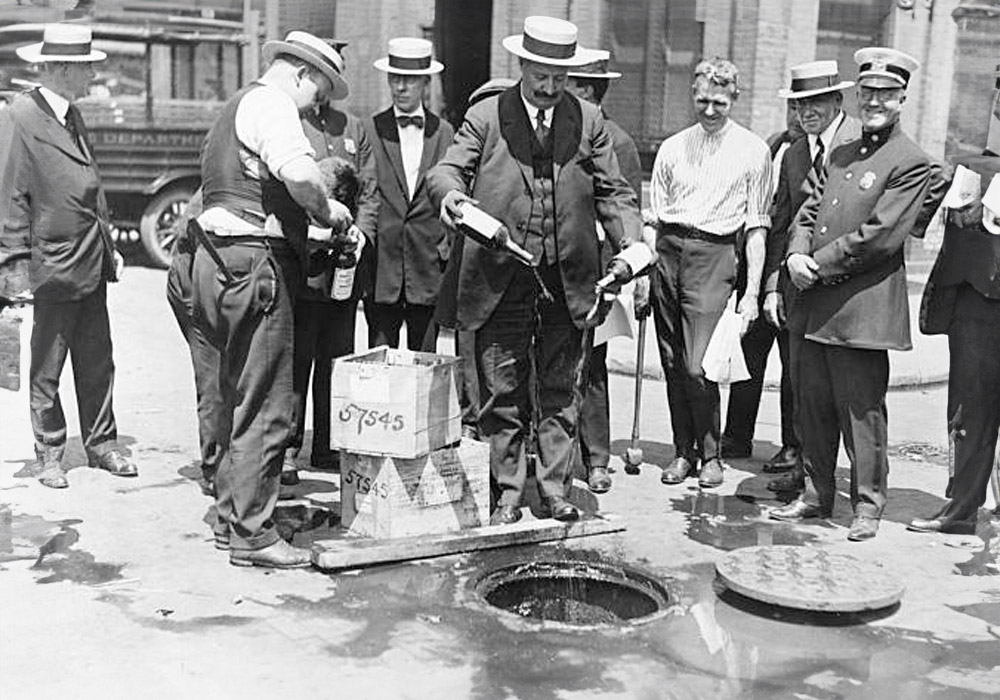
1920
Prohibition Begins
A nationwide constitutional ban on the production, importation, transportation, and sale of alcoholic beverages in the United States begins January 17, 1920.
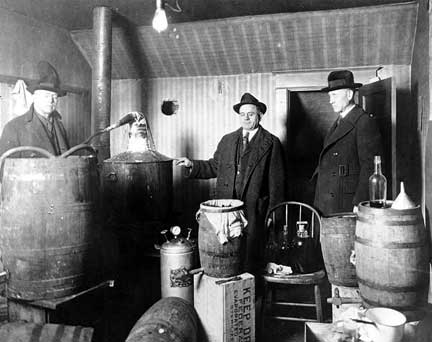
1932
The Legend Begins
As the Great Depression continues to have an effect on the economy, the Sextro family begins housing a bootlegger in the attic of their Carroll County family farm in January 1932.
With a family to support, Lorine Sextro learns from the bootlegger she’s housing and begins distilling her own small-batch 100 percent rye whiskey at her Carroll County farm in May 1932.
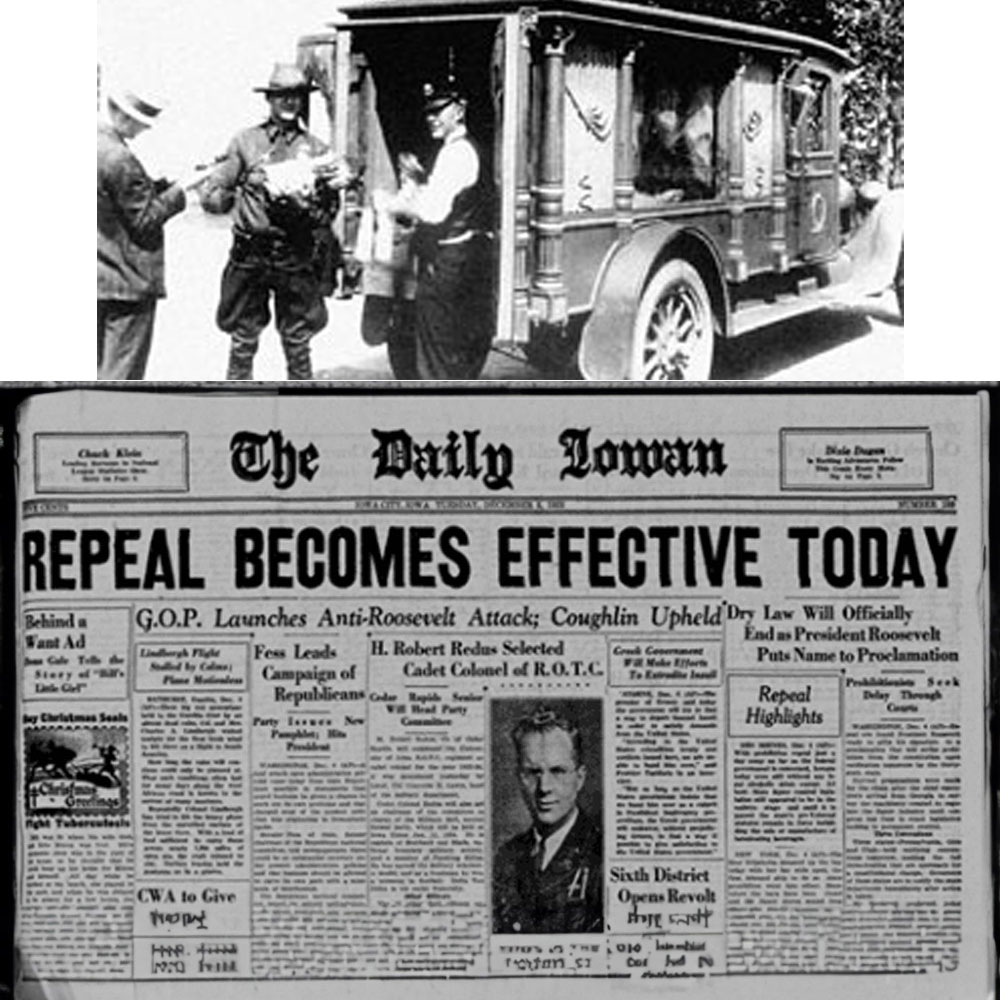
1933
Feds Raid Farm & 18th Amendment Repealed
ContentDue to an error identifying the correct address, a neighboring farm was raided by Federal agents looking for illegal whiskey in May 1933. Barrels made at the Sextro farm are said to be buried in nearby fields in Carroll County. Their whereabouts are still a mystery today. The Sextro family was never caught.
President Roosevelt ratifies the 21st Amendment on December 5, 1933, repealing the 18th Amendment in the process. It ends the unpopular nationwide prohibition of alcohol.
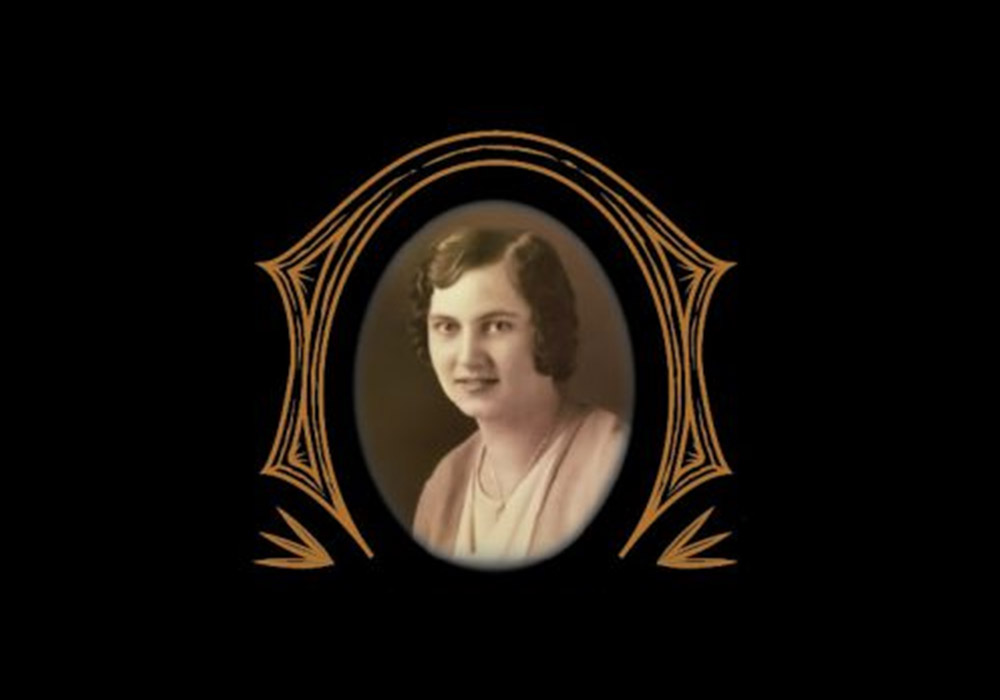
1989
The Family Secret is Revealed
Lorine Sextro, now a grandma, shares her bootlegging past and passes on her secret rye recipe at aged 78 to a family friend. She refused to let her children know in case they got in trouble with the law.
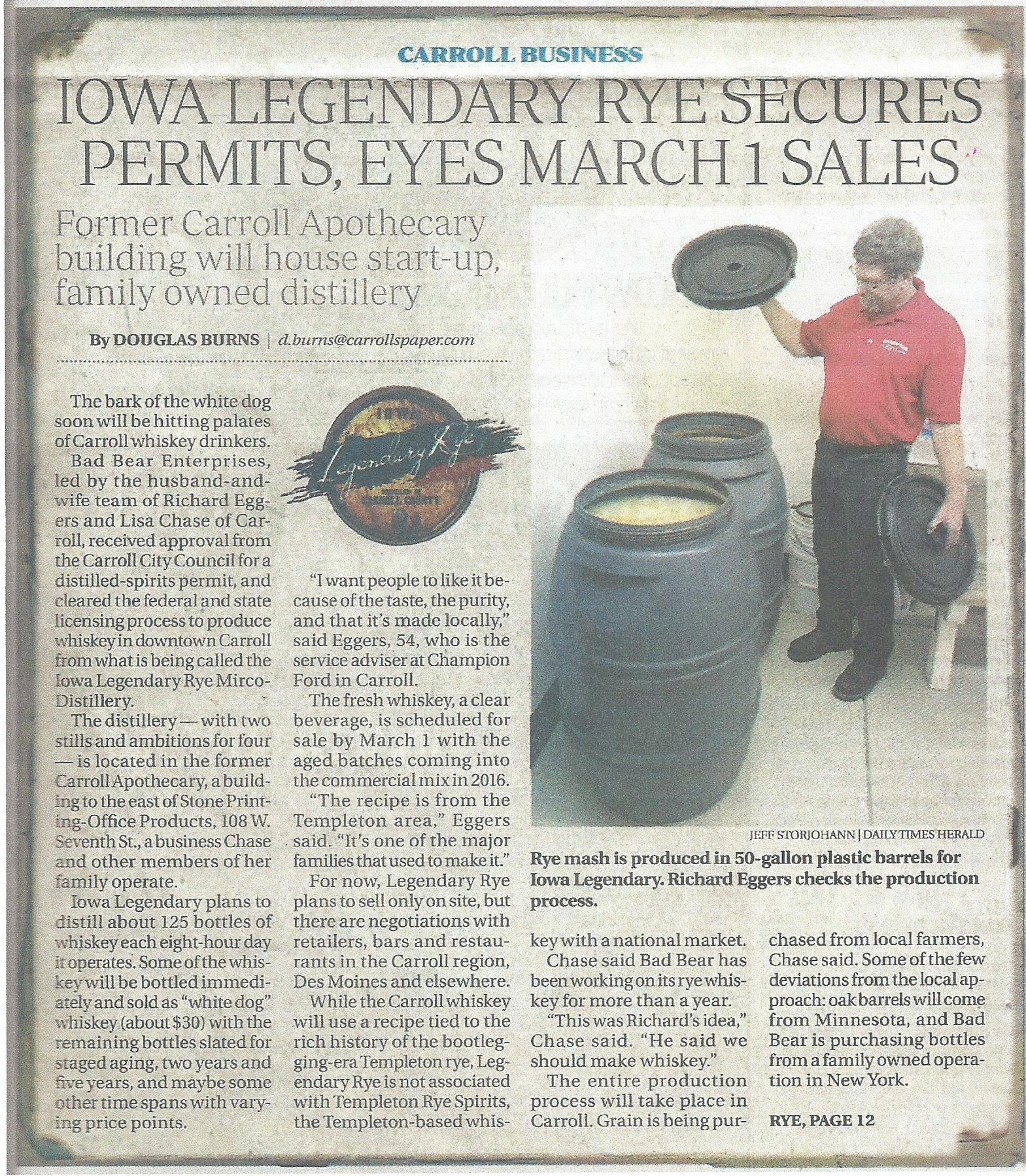
2015
The Legend Resurrected
Iowa Legendary Rye begins production using Grandma Sextro’s Prohibition-era recipe and distilling process. Rye is made in 26-gallon stills and aged in 15-gallon barrels. When Grandma Sextro was asked why she did it this way she responds, “Have you ever tried running from the law with a 40-gallon barrel?!”
The first bottle of Iowa Legendary Rye ever made legally is sold in December 2015.
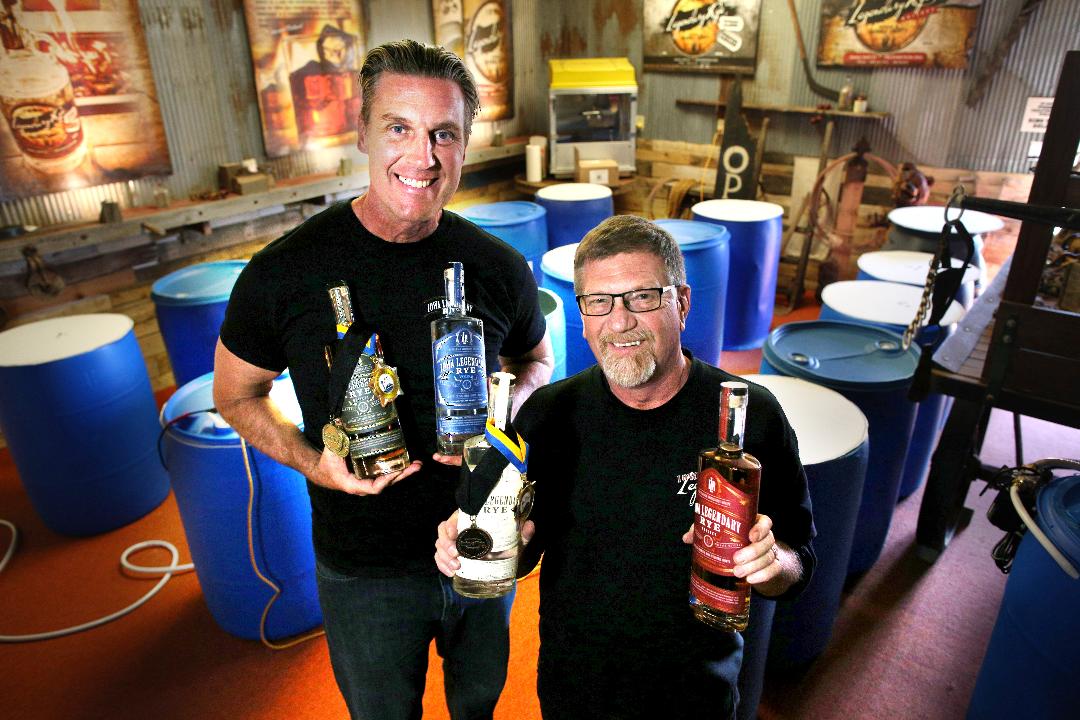
2017
Keeping it in the Family. Buried Treasure, & Present Day
Grandma Sextro’s grandson Heath Schneider joins Iowa Legendary Rye after learning about his family’s past in a news story.
The hunt for the Prohibition-era barrels of rye said to have been buried in a Carroll County field continues using specially trained sniffer dogs.
The Legend Continues …
MORE ABOUT OUR HISTORY
THE HISTORY OF PROHIBITION ERA RYE WHISKEY
When we talk about the history of prohibition-era rye whiskey, well, many individuals might not know that. The first whiskey recorded in America was rye whiskey.
In 1640, William Kleft, the Director of the Dutch Colony of New Amsterdam, directed a rye whiskey distillery.
Rye was the preferred grain in the Netherlands and Germany, reinforcing beliefs that Germanic culture contributed to American whiskey traditions as the Scottish and Scotch-Irish people in Colonial America. Making rye whiskey was popular in areas settled by Germanic peoples, such as the “Pennsylvania Dutch.” The Beams, the Overholts, and the Schenks are all early Pennsylvania distillers originally from Germany or Switzerland.
Rye whiskey was famous in those areas because rye thrived there – probably better than corn. This early rye whiskey was an unaged product produced by farmer distillers in the frontier region surrounding modern Pittsburg and more significant operations further east near Philadelphia. It gained popularity following the American Revolution, as British political maneuvers caused the supply of sugar cane from the West Indies to dwindle. To meet demand, America needed to develop a new source of distilled spirits.
By the 1820s, rye whiskey had developed into a mature spirit. Melville describes the blood from a harpooned whale as “red as some Old Monongahela” in the novel Moby Dick, indicating that aged rye was widespread and that Americans would recognize the simile. However, there was sufficient demand for unaged rye that Pierre Lacour included recipes for both aged and unaged Monongahela ryes in his 1860s book of rectifying.
Throughout the nineteenth century, rye whiskey was a prevalent spirit in the northeastern United States. The fact is that that region of the United States had a higher population density than the southern or western states. While rye production concentrated in Pennsylvania and Maryland, rye produced in Kentucky and other Ohio Valley states with thriving whiskey industries.
In Pennsylvania, rye whiskey distilled from 100% straight rye was the preferred method. Maryland rye or primarily rectified rye sweetened with cherry or prune juice for flavor. Both styles were trendy in the nineteenth century.
Then the 1906 Pure Food and Drug Act came dangerously close to eliminating Maryland Rye as a category. Force labeled as a blended whiskey during the rising popularity of straight corn whiskey.
Prohibition dealt the next major blow to the popularity of rye whiskey.
After the repeal of Prohibition, distilleries returned to Pennsylvania and Maryland, but not in the same numbers as in Kentucky. Maryland rye as a blended whiskey eventually lost market share to aged bourbon, and distilleries began to close. Pennsylvania reverted to a control state, with politicians hostile to the distilling industry. Pennsylvania distilling became uneconomical due to rising taxes and stricter regulations than in Kentucky. Due to the growing popularity of bourbon, sales of Pennsylvania rye declined, and companies such as National and Schenley relocated rye production to their Kentucky distilleries. Many New Englanders began drinking Canadian Whisky and dubbed it “Rye” due to the majority of Canadian whisky made with rye grain.
In the nineteenth century, it was the preferred alcoholic beverage in the United States of America. Then came Prohibition, and rye was never the same again. Due to declining production standards developed a reputation as a bottom-shelf paint thinner, allowing bourbon to usurp it. It is currently experiencing a renaissance, resurfacing in the spotlight due to the emergence of several astute new brands.
Rye whiskey is generally more delicate, spicy, and complex than bourbon. Because rye is a much more difficult grain to work with than corn, many distillers combine it with other grains. To be classified as straight rye whiskey, the mash must contain at least 51% rye and be blended with other grains such as corn, wheat, or barley. Proportions are not a reliable indicator of quality, as flavor profiles vary widely regardless, but for a true expression of the spirit, try a 100 percent rye. Iowa Legendary Rye is an excellent example, hailing from the prohibition era circa the 1930s from Northern America in the booziest little-town during Prohibition. For generating over 300 gallons of this sweet nectar, and saw critics from mob bosses to movie stars and politicians sip on this new delicious style of spirits. Not only was it safe to drink, but it went so well with an assortment of rye cocktails and occasions.
The good stuff can be sipped straight or with a splash of water. Rittenhouse, Knob Creek, and Old Overholt are all readily available, while the Purple Label Rye from the Iowa Legendary Rye Distillery is worth seeking out. Additionally, nearly any cocktail that calls for bourbon twisted with rye; both the old-fashioned and Manhattan benefit from the dry, spicy punch. However, arguably the most iconic rye cocktail is the Sazerac (see box copy), originally made with cognac until supply shortages necessitated a switch to rye. It is a straightforward but potent concoction of rye, absinthe, and bitters that tastes divine but packs a punch.
These are revival days for brewing and distilling. Brewing had been a macro-lager shambles until a few years ago, when craft brewing exploded, providing us with roughly ten million options in even the smallest liquor stores. Craft distilling is experiencing a similar renaissance. Once there were only a few massive brands, liquor store shelves are now brimming with independently produced whiskeys, vodkas, gins, and rums. Since the turn of the century, spirit enthusiasts have not had this much choice.
Rye whiskey has been and continues to be a critical component of the craft distillery movement. Rye has the most profound historical roots in American distilling. We would never discourage one from enjoying a fine bourbon, but rye whiskey is a must for those seeking to immerse themselves in American distilling culture.
Rye whiskey is, in some ways, the inverse of bourbon. It is made in the same way as bourbon but with different ingredients. Whereas bourbons are typically sweeter and smokier with caramel notes, rye whiskey is spicier with pepper, grass, and grain notes. Just as bourbon must contain 51% corn to be considered American Rye, the spirit must contain 51% rye grain, though, as, with bourbon, most expressions will use a higher percentage. Additionally, rye is never distilled to a 160, aged to a proof greater than 125, or bottled to prove more outstanding than 80. Barrels, like bourbon barrels, are newly constructed, charred oak casks.
Where rye differs significantly from the bourbon is in its history. It is not a bloody history, as moonshine is, or a history rooted in the American slave trade, as Jack Daniels is.
The history of rye whiskey is about how quickly one can achieve fame and fortune in America, how quickly one can lose it, and how destruction does not mean one is ultimately out of the running.
The two primary states we will discuss in this section are Pennsylvania and Maryland, and we will borrow a phrase from our Moonshine article and say that Pennsylvania and Maryland developed such large distilleries as a result of Scotch-Irish immigration. Both Scotch and Irish whiskey are made primarily from barley, but barley did not adapt well to North America’s new climate. However, rye did.
When they arrived, the immigrants constructed small stills to carry on their long distilling tradition, using the rye grown on their modest farms and inadvertently inventing an excellent new American spirit. From there, whiskey manufacturing evolved from small, private operations to large, commercial operations.
Maryland and Pennsylvania were regarded as the premier rye whiskey producers. Pennsylvania’s premier style was Monongahela Rye, a whiskey named after the valley of the Monongahela River, where it was first produced. According to legend, the whiskey earned its reputation by chance. Aging the whiskey was a necessity, not a deliberate act by the distillers. Before the invention of steamboats and automobiles, shipping whiskey took an extended time, and the time required for storage and travel meant that the whiskey could be two years or older when it finally arrived at its destination.
Maryland’s version of rye whiskey included more corn in the mash, resulting in a sweeter whiskey that is slightly more approachable to the uninitiated. It was no less a rye whiskey than anything made in Pennsylvania.
Following the Revolution, rum was not as readily available, as the newly established country had just concluded a protracted rebellion against the world’s most significant naval power. At the same time, rum was manufactured from molasses and sugar cane. While sugar cane was only widely available in the Caribbean, the liquor was not reaching America, creating a void in the spirit world, which Americans immediately felt.
Simultaneously, the Scotch-Irish immigrants mentioned previously had honed their craft, transforming it from a small local operation into something capable of supplying a much larger operation. They seized the opportunity to fill the void left by rum and the new whiskey enthusiastically purchased by urban populations—a new America’s spirit.
The mark quickly became profound. This was whiskey production on a scale that would boggle the minds of modern rye drinkers. Kentucky produced 2.2 million gallons of bourbon in 1810, a perfect whiskey with a long history in American distilling. Pennsylvania shipped nearly three times as much rye that year, 6.5 million gallons of mostly Monongahela rye. That is a significant difference between what bourbon distillers market as traditional American whiskey and what Americans actually drank.
Rye whiskey was so ingrained in the American psyche that in the late 18th and early 19th centuries, George Washington operated his own distillery. Although it was a small operation by modern standards, when massive distilleries produce millions of gallons of whiskey, George Washington was a veritable whiskey tycoon in his day. His five still, 11,000-gallon production was enviable, and modern consumers are flocking to Mount Vernon to sample Washington’s whiskey once again. That would be analogous to Obama leaving the White House and establishing a craft brewery comparable to Yuengling’s current output. Moreover, ensuring that it is equally successful.
The credibility of these claims may be questioned, as rye is not as easy to drink straight as bourbon, Scotch, or Irish whiskey. Its flavors have the potential to overwhelm or alienate drinkers accustomed to sweeter, smoother spirits. However, drinking whiskey straight was not the only way it was consumed. In the 1800s, people mixed cocktails in droves. The Manhattan, Old Fashioned and Sazerac were all made with rye and were all insanely popular. Modern speakeasies would salivate at the prospect of mixing drinks in the quantities enjoyed by the people of the nineteenth century.
This emphasis on cocktails and mixed drinks continued well into the twentieth century when rye whiskey’s empire faced its first serious challenge since it originated in Pennsylvania and Maryland. However, these challenges would not be another type of alcohol. Prohibition and two World Wars were the culprits. It was not going to be a good day for rye.
The role of Prohibition in the rapid decline of rye whiskey is unsurprising. Rye is one of the most expensive and labor-intensive grains and whiskeys to produce. If many people purchase it or distill it as a hobby, this expenditure of money and effort has a negligible effect on the process. You have a reasonably stable operation, which enables you to produce an affordable, delectable whiskey.
However, once the federal government determines that your product is not only illegal but also unconstitutional, your small distillery becomes significantly more problematic.
Its market crashed almost instantly, just as most American breweries and distilleries did in the early twentieth century. Furthermore, while authentic American rye is more expensive to produce, Canadians do not appear to be as strict about mash standards. Canadian whisky, like American whisky, can be labeled rye, although rye is not a required ingredient in the mash. Rye became the frat party equivalent of bottom-shelf vodka.
Apart from the economics of supply, demand, and illegality, rye has taken a beating in contemporary pop culture, with its once-famous name dragged through the mud Hollywood could find. It transitioned from being everyone’s favorite whiskey to being what drunkards and lay bouts drank in their never-ending search for a quick, inexpensive fix. In the 1945 film The Lost Weekend, rye was placed in the hip flasks of 1930s gangsters and caused Ray Milland to pass out. That was some truly awful public relations for a whiskey that could not afford it.
Only a few distilleries remained, most notably in Maryland. Given that Maryland never ratified the 18th Amendment, it appears as though the state government never invested much effort in enforcing it. Several Maryland distilleries produced medicinal whiskey (like how people obtain marijuana for “glaucoma”), while others avoided drawing attention to their moonshining.
Let us now turn our attention away from Prohibition and toward something we discussed earlier. While bourbon distillers would like to believe that corn whiskey made to their exact specifications is the pinnacle of the American distilling tradition, and it certainly deserves the current level of popularity, the truth about its popularity is not quite as romantic as marketers believe. It is riding the cultural wave generated by the perfect storm that destroyed rye whiskey.
During World War I and II, the US government subsidized corn, making it a far more attractive crop for farmers. Corn became more affordable and accessible, while rye retained its inherent cost and difficulty. Distillers flocked to corn before and following Prohibition to make a quick buck and reestablish their industry. It was a business decision more than a sentimental attachment to traditional American distilling.
After the world stopped collapsing and American consumers could refocus on alcohol, they began purchasing vodka and gin, courtesy of a particular smooth-talking British secret agent. Vodka and gin cocktails became associated with classy drinkers, and people shied away from brown liquors that were not bourbons or Scotches. By the 1980s, rye had become the drink of choice for Don McLean’s aging alcoholics. It was a sad end for a whiskey that had spent nearly two centuries as the preferred whiskey of Americans and three centuries as Western Pennsylvania’s most proud product. However, history has a way of rectifying such injustices, and a new generation of cocktail enthusiasts was about to discover what rye whiskey can do for the adventurous mixologist.
The United States’ History Seen Through the Lens of Rye Whiskey THE SUCCESSION OF RYE WHISKEY
It is unsurprising then that the American colonists brought a station capable of processing large quantities of grain, which was impractical during this era, the distillers.
When the influenza pandemic began in the United States in 1918, a fearful nation turned to an unproven but familiar remedy: whiskey. There was only one issue. By that time, more than half of the states had enacted Prohibition laws, making liquor difficult, if not impossible, to obtain legally.
As citizens in so-called dry states pleaded for whiskey to prevent or treat the deadly virus, some astute officials devised a solution: liberate the vast stores of bootleg liquor confiscated since the statewide prohibition laws took effect. While some of the contraband poured down sewers, much of it remained locked away as evidence or possibly in anticipation of eventual repeal Newspapers across the United States reported that military doctors were administering confiscated whiskey in Army camps hard hit by the flu. Two railroad cars of it reportedly rolled into besieged Camp Lee in Richmond, Virginia. Hundreds of quarts had dispatched to fighting men for an influenza outbreak at Camp Dodge, Iowa, where more than 500 soldiers had already died, the newspapers reported.
However, officials soon began using their bootleg whiskey in civilian hospitals as well. The sheriff of Omaha, Nebraska, donated 500 gallons to local hospitals. Meanwhile, the Internal Revenue Service commissioner in Washington directed his North Carolina revenue agents to distribute the confiscated whiskey to hospitals throughout the state.
The medical community was divided over whether whiskey was genuinely beneficial in combating influenza or for any other purpose. In 1916, the prestigious United States Pharmacopeia, which publishes standards for prescription and over-the-counter medications, removed whiskey, brandy, and wine from its listings. The following year, the American Medical Association’s House of Delegates endorsed Prohibition, resolving, over the objections of some delegates, that “the use of alcohol as a therapeutic agent should be discouraged.” A revenue agent dressed in a waistcoat designed to conceal whisky during America’s prohibition era, circa 1923.
Despite this, many physicians continued to recommend and prescribe whiskey for the influenza pandemic and various other ailments. When the American Medical Association surveyed physicians on the subject in 1922, 51% stated that whiskey was a “necessary therapeutic agent.” Some physicians believed alcohol stimulated the heart and respiratory systems of patients who were weakened by illness, while others believed its sedative effects made suffering patients more comfortable.
Even in states that prohibited alcoholic beverages, physicians could frequently write prescriptions for medicinal whiskey, which pharmacists could dispense with certain restrictions. In Colorado, for example, physicians were required to obtain state-issued numbered prescription forms, and prescriptions were limited to four ounces. In Michigan, physicians could prescribe up to eight ounces but were required to indicate how many prescriptions the patient had already received in the preceding year; the pharmacist was then required to forward the form to the county prosecutor. In Indiana, physicians could only prescribe grain alcohol in its purest form.
Cities with ample supplies of whiskey occasionally distributed it directly to anyone with a doctor’s prescription. For example, in Burlington, Vermont, the local police department provided free prescriptions through the city’s epidemic emergency fund. Local authorities in Nashville distributed 10,000 half-pints of whiskey to residents with prescriptions.
Certain physicians appeared all too eager to reach for the prescription pad. In 1919, four physicians and a druggist were arrested in Pittsburgh as part of a scheme to sell whiskey to “patients” who had never been examined. The doctors were compensated $1 for each prescription, while the pharmacist was compensated $5 per bottle of whiskey. Newspaper reports stated that the scheme was so successful that local bootleggers were forced to lower their prices in order to compete.
Of course, residents of wet states were still free to purchase whiskey and other spirits as they pleased. Concerned about the potential impact of the influenza pandemic on his workforce, the president of a Baltimore roofing company purchased a large bottle of rye whiskey and instructed his employees to help themselves “whenever, in their individual estimation, it may be indicated.” He stated that not a single one of his over 200 men had fallen ill. He made no mention of whether they fell from any roofs.
The manufacturers of over-the-counter patent medicines, which the Food and Drug Administration did not fully regulate at the time, saw a profit opportunity as well. Along with newcomers such as Influenzene and Spanfluenza tablets, many widely advertised concoctions that had been around for years added Spanish influenza to the list of ailments they claimed to prevent, treat, or even cure. Apart from being of little or no medical value, they all had a high alcohol content.
Tanlac, for example, billed itself as the “Master Medicine” and claimed to cure almost anything, contained 17% alcohol. And Peruna, one of the era’s most successful patent medicines, contained a reported 28%.
Meanwhile, it was reported that pro-Prohibition forces were becoming concerned. Would all the publicity surrounding whiskey’s alleged medical benefits derail their efforts to ratify the 18th Amendment and make Prohibition permanent? They were unnecessarily concerned. By January 16, 1919, the Amendment had garnered the necessary votes from all states and took effect a year later.
To put it mildly, not everyone was pleased with the outcome. When a soldier on a troopship returning from the war in 1919 interrupted a former government official who was giving the men a patriotic speech, he spoke for many of his comrades. “Yes, we fought for democracy,” the soldier is said to have exclaimed, “but all we got was Spanish influenza and Prohibition.”
As with everything in history, rye whiskey is making a comeback in the bar scene. While rye remains dwarfed in comparison to other types of whiskey, its volume has increased more than 500 percent since 2009, far outpacing the growth of those other whiskeys. Jack Daniel’s and Jim Beam have taken notice and launched their own rye expressions, while Wild Turkey’s was nearly sold out.
Other craft distillers have taken notice, with Anchor Distilling establishing their rye 18 years ago, eclipsing even Mount Vernon’s efforts to revive George Washington’s styles. These are whiskeys made entirely of rye and aged only briefly, if at all, how the earliest versions of rye were sold. They are sharp, herbal, sweet, and essentially clear, making them ideal for reintroducing the fundamentals of cocktail making.
Buffalo Trace (not technically craft distilling, but their experimental stills qualify) supplied the rye that helped make the Sazerac famous in the 1800s and has relaunched their brand. Sazeracs, Old Fashioneds, and Manhattans all benefit from a more nuanced flavor when crafted with rye, and the public is taking notice. Plus, something is more suited to the “seasoned drinker,” millions of people automatically assume they are old pros.
We have already discussed Mount Vernon’s distilling operation, but it is worth repeating. They create their whiskeys using the recipes discovered during their research into George Washington’s recipes. They are more than willing to discuss their distillery and alcohol history in America and partaking in a whiskey tasting bringing anyone one step closer to having wooden teeth and unwavering devotion to colonial independence.
Surprisingly, not all established brands are reviving. Old Overholt, one of the oldest rye whiskey brands, if not the oldest, has covered every aspect of rye’s life in America except for the modern twist.
They were enormous in the 1800s, were decimated by World Wars and Prohibition (despite having a permit to sell “medicinal whiskey”), were forced to turn their whiskey into cheap, diluted rotgut, were eclipsed mainly by vodka in the latter half of the twentieth century, and were eventually acquired by what became Beam Suntory. However, rather than returning to the shelves and into cocktails, Old Overholt is in a state of limbo.
Beam Suntory is convinced that the rye revival is a viable movement, and as a result, they are delegating some of their rye brands to the background, including Overholt. Hopefully, another year or two of solid sales will result in the brand’s revival.
Rye’s renaissance is mainly due to something with which you are undoubtedly intimately familiar. Bartenders and their patrons are becoming more daring. They began with an authentic Manhattan and expanded from there, creating an increasing number of cocktails around the spicy foundation of flavorful ryes.
Mixologists sought after for their experimental flavors, not for their watered-down vodka drinks.
Additionally, new distilleries are eager for the opportunity to make their mark with an unknown whiskey variety. They see rye as a way to get in on the ground floor of a whiskey revival with distinct flavors.
The public adores the novel flavor, and if these distilleries succeed in creating memorable rye, they can count on a few years of fervent brand loyalty. With an increase in the number of people mixing rye-based cocktails at home and requesting specific brands at bars, distilleries want to ensure they are the ones being requested.
The pre-Prohibition whiskey of the United States of America is making a comeback, thanks to a new generation of craft producers. Here’s the skinny on the hooch and three locations where one can try it.
Rye whiskey is bourbon’s boisterous older brother, with more personality, intensity, and an acquired taste. While variations exist throughout the world, Canadian whiskey is frequently referred to generically as rye but is fundamentally an American spirit. This is where Prohibition and Rye Whiskey come into play.
Al Capone was a massive supporter of the Iowa town’s primary export. What comes to mind when you consider the quintessential American spirit? From a historical perspective, rye whiskey has to be a front-runner. According to author Bryce Bauer’s new book, Gentlemen Bootleggers: The True Story of Templeton Rye, Bootleggers, and a Small Town in Cahoots, the story of rye is essentially the story of the American heartland.
Bauer’s book focuses on Templeton Rye, a Prohibition-era brand that was rumored to be Al Capone’s preferred beverage. The label was resurrected in recent years by a group that included Bauer’s father. You can probably find it at your neighborhood liquor store.
Templeton, Iowa is referenced in the brand name. Bauer grew up in the neighborhood, hearing tales of bootlegging from town elders. Like many other towns in the American Midwest, Templeton was founded by German Catholics who tended the rye fields and distilled the grain.
At the turn of the twentieth century, distilling was thriving in Iowa. Then, a series of events precipitated a massive social change in these communities: World War I heightened anti-German sentiments. Alcohol was prohibited during Prohibition. Moreover, in the 1920s, the Midwest experienced a farm crisis. Templeton’s primary industry became bootlegged rye, which became so popular that the term “Templeton rye” referred to all of the town’s liquor. Templeton rye employed people and kept their families financially afloat during the farm crisis. By the time Prohibition was repealed in 1933, Templeton rye had developed a regional reputation.
Bauer’s book delves into historical records to unearth the backstories of the major players in Templeton rye production and distribution. While the book is informative, it is at times a little, pardon the pun, dry. This demonstrates, however, that rye is a true American classic. Not only was the spirit invented in this country (corn-based bourbon was developed later), but its history is fraught with criminal activity, ethnic tensions, resourcefulness, and boozy barn dances.
What could be more American than that?
Conclusion: In the mood for some delectable rye? Make a classic Manhattan or an Old-Fashioned one with it. Splash a sugar cube with Angostura bitters and muddle it in a rocks glass with a spoon. Stir in a large square ice cube (or a few smaller ones), followed by three rye fingers. Raise your glass to the American Midwest, which has bestowed upon us our national spirit.
